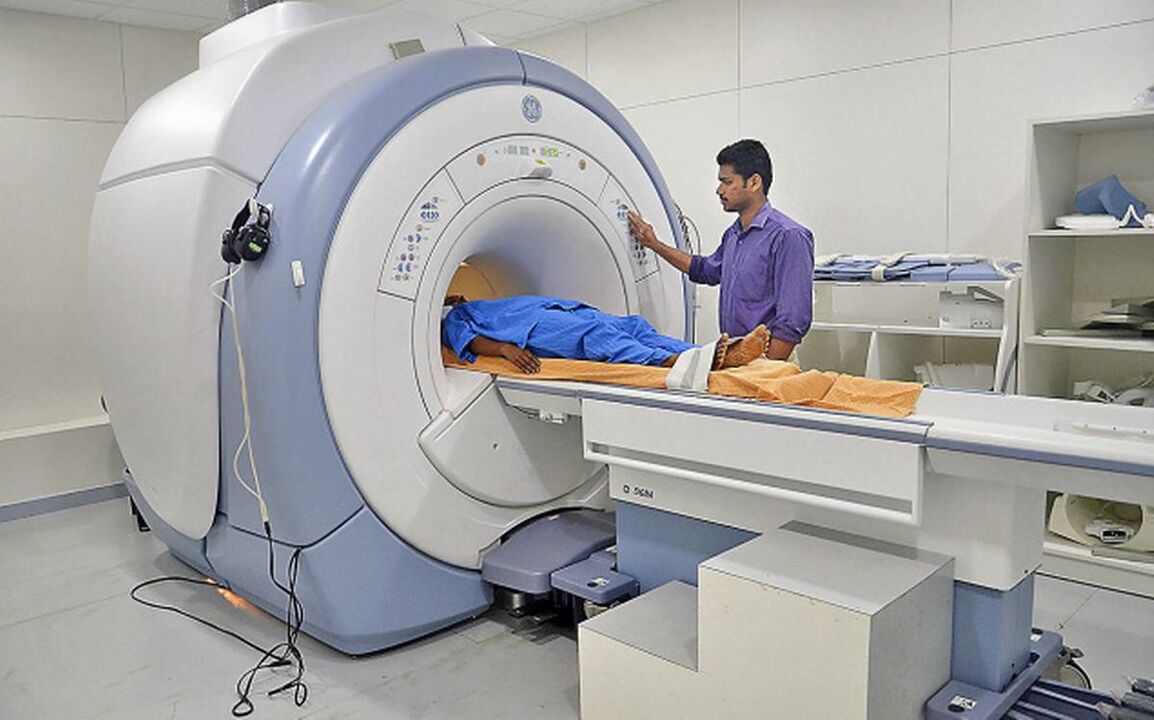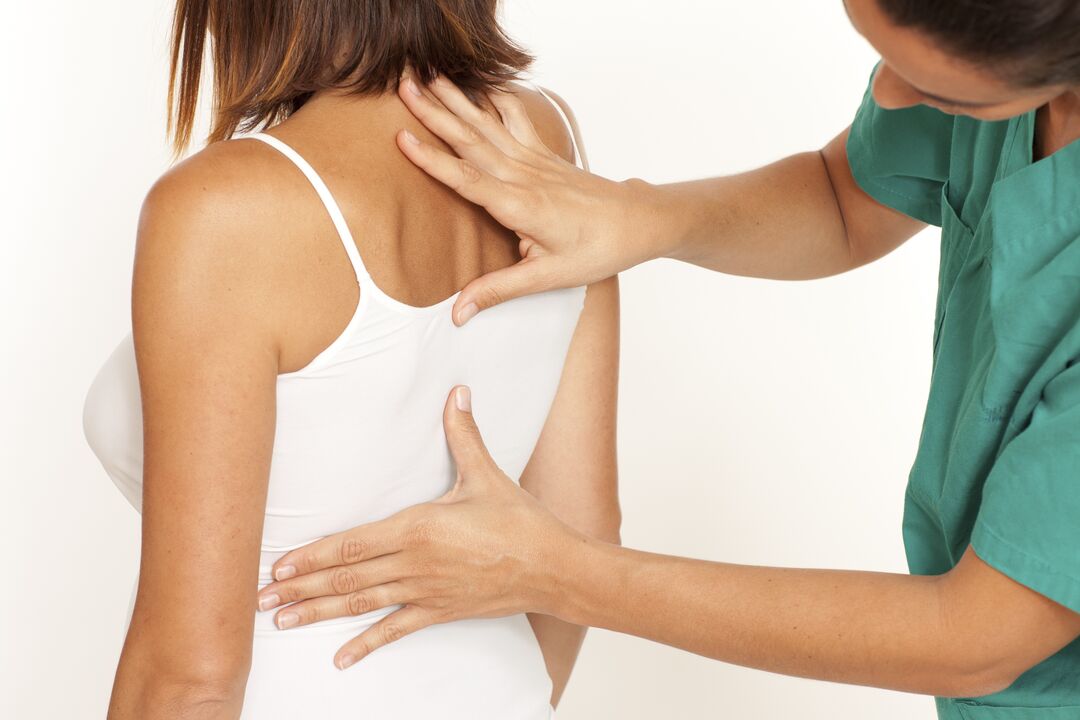The symptoms of thoracic osteochondrosis depend on which vertebra has had a dystrophic lesion, and its intensity depends on the changes that take place in it. An experienced specialist, after hearing the patient’s complaints, will be able to make a correct diagnosis and suggest which parts of the spine have undergone serious changes and destruction. The sooner a doctor diagnoses thoracic osteochondrosis and prescribes medication, the sooner relief will come.
Thoracic osteochondrosis is less common than cervical osteochondrosis, because the thoracic spine is less susceptible to stress and deformation. But, nevertheless, it gives a lot of pain and discomfort and has a variety of symptoms.

Thoracic osteochondrosis, symptoms and signs
The pain is localized mainly between the shoulder blades or in the intercostal space. Often, thoracic osteochondrosis manifests itself as lumbar pain in the costal part of the body. Patients describe such pain with a feeling of "interest in the chest", their movements are disturbed, as the pain pierces at the slightest careless movement. The pain is aggravated by coughing, sneezing, taking deep breaths, and turning the body. Shortness of breath appears, breathing becomes shallow and frequent. It is very difficult for the patient to lift his hands up or tilted, as this causes sharp and severe pain. The difficulty is also caused by body vibrations such as riding a bicycle, a car on a bumpy road, as well as any jumping. Cooling the body can trigger worsening pain, even with the right treatment, the disease can start with a renewed vigor.
Often the pain is located in the space between the ribs. This is due to compression of the nerve root, which leads to intercostal neuralgia. The sensation of pain becomes stronger at night, when turning from side to side or changing posture, the patient wakes up from a sharp piercing pain, even despite treatment with painkillers.
Sweating, fatigue and rapid fatigue accompany the symptoms of pain, sometimes there is a local increase in temperature in the inflamed segment of the spine.

Signs of dorsago and dorsalgia
A strong and very sharp pain is called dorsago. With thoracic osteochondrosis, dorsago symptoms occur in people who sit motionless for long periods of time in a forward -leaning position of the body. With a sudden rise or change of position, the body is stabbed by a sharp pain. It is so loud and unexpected that it takes your breath away and becomes difficult to breathe. The muscles of the chest and back become rock-like, sometimes piercing with cramps. The treatment relieves pain and brings relief to the patient.
Dorsalgia, on the other hand, is a excruciating pain. It wasn’t so intense, but always reminded of itself. With sudden and rapid movements, coughing, sneezing or deep inspiration, the body also pierces with acute pain as fast as lightning. Roundness and tilt of the body are also given with difficulty and pain. The back and chest muscles are tense and a feeling dominates, as if the upper body is pulled together by a belt.
To relieve or temporarily relieve the condition from this pain, it is sometimes enough to walk or do light exercise.
Signs of neurological nature in osteochondrosis
Often, osteochondrosis of the thoracic segment is given, a symptom of a neurological nature. This is manifested by a feeling of "wrinkling" or loss of sensation in the abdomen or upper chest. Sometimes patients notice tension or stiffness of the back muscles, especially the upper part, as well as the chest. In more severe and advanced cases, there is a violation in the work of the pelvic organs.
In men and women, thoracic osteochondrosis progresses in a very similar way and the symptoms are similar. The only difference is that women have later manifestations of the disease. Women are prone to this disease during menopause. This is due to a decrease in the hormone progesterone, which protects the spine, or more precisely the vertebral discs, from wear and tear.
With osteochondrosis, a woman may experience strange symptoms, such as peeling skin and brittle nails. Women are more difficult to tolerate thoracic and cervical osteochondrosis, this is due to the low pain disability in the weaker sex.
Men, on the other hand, turn to specialists with osteochondrosis of the thoracic region many times more often than women and the average age is about 30-40 years. Men may complain of decreased potency. The most important thing here is to confess to the doctor about the intimate problem and not to treat it yourself.
Signs of osteochondrosis can be confused with other diseases
Since there are many nerve fibers and ends in the thoracic area, therefore, pain in the back of the sternum can radiate in any direction. The symptoms of osteochondrosis are very similar to other diseases, which exacerbate the condition with diagnosis. Early diagnosis of osteochondrosis and initiation of treatment are very important for better outcomes from the disease.
Many people confuse osteochondrosis with heart disease. But here it is worth keeping in mind some differences. First, with thoracic osteochondrosis, the pain lasts longer and cannot be treated with heart medication. And the second sign is that there is no increase in blood pressure, as is often the case with diseases of the cardiovascular system. And most importantly, the ECG results did not show any abnormalities in the work of the heart.
In women, the pain can spread to the mammary glands, and this sign of thoracic osteochondrosis is very common. In this case, it is necessary to consult a mammologist and rule out mammary gland disease.
Sometimes patients complain of pain in the epigastric area, which can be confused with gastritis or stomach ulcers. Pain may also be localized in the right hypochondrium and unqualified medical personnel may suspect cholecystitis or pancreatitis. With pain in the lower abdomen, appendicitis can be suspected. In such cases, it is advisable to conduct additional ultrasound examination of the abdominal organs, X-rays and EGD of the abdomen, and, of course, clinical blood tests.
If the lower part of the thoracic spine is affected, the patient will have signs of intestinal disease. But this condition does not depend on the food taken and the pain worsens with physical exertion.

If osteochondrosis has affected the upper part of the spine, then the pain will spread to the pharynx and esophagus. Patients will feel signs of foreign bodies in the throat and there may be difficulty swallowing food, especially poorly chewed ones.
Only a doctor should deal with the diagnosis and treatment, self-medication in this case is unacceptable.
The influence of profession on the development of osteochondrosis
Specific some professions can develop osteochondrosis. This is due to an inactive lifestyle, especially in professions like truck drivers, pilots, pilots. And also in the risk group are professions associated with lifting weights, for example, loaders. By lifting and carrying prolonged loads, rubbing and flattening of part of the vertebrae occurs, which also leads to osteochondrosis and not only the thorax, but also the cervical and lumbar segments of the spine. In further cases, the arms or back begin to numb closer to the shoulder blade area. This is a wake -up call to call a specialist for examination and treatment.
Most office workers are prone to cervicothoracic osteochondrosis. That is, not only the vertebrae of the thoracic region, but also the cervical vertebrae are involved in the process of change and destruction. Due to sitting for a long time in front of a computer, even in the wrong position, it leads to weakness and spasm of the muscles that support the spine. The spine begins to shift, thus pinching the nerve.
Also, not moving in one position, the blood flow of the intervertebral disc is disrupted, leading to starvation of the disc tissue and its destruction. They experience pain in the head, shoulders and chest. They experience hearing loss and tinnitus. With a sudden rise or movement of the head, the worker may lose consciousness, as the work of the vestibular apparatus is disrupted. Vision is often impaired, and flies appear before the eyes. The muscles of the shoulder girdle and chest begin to ache, as after a long workout.
It happens that after treatment it is worth changing your profession, because frequent relapses in the old workplace are possible.































